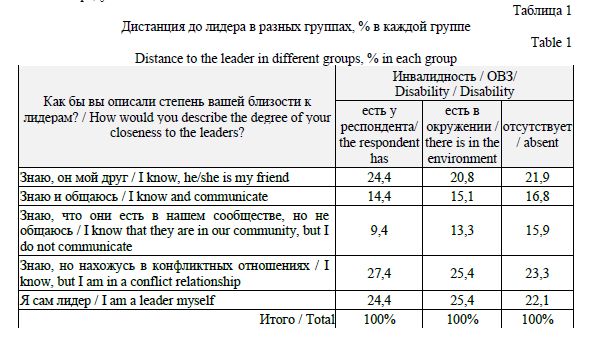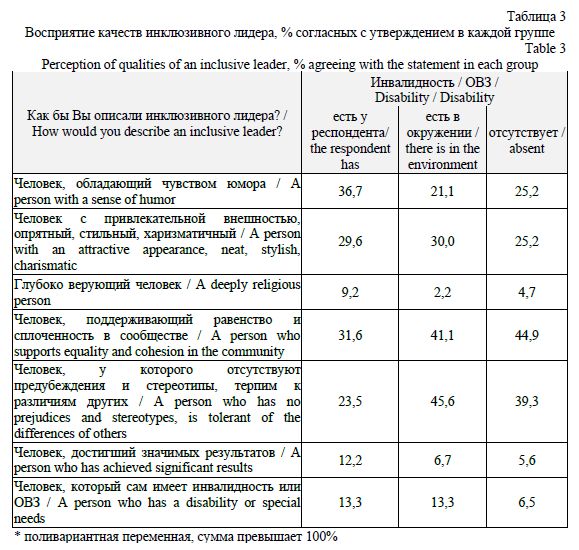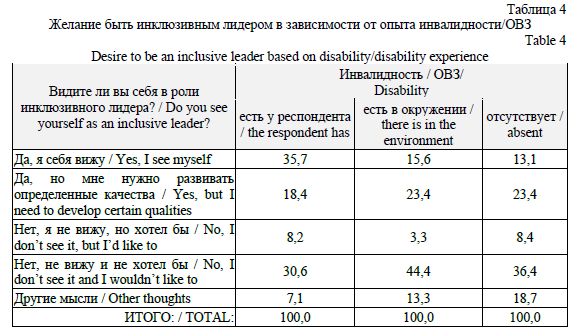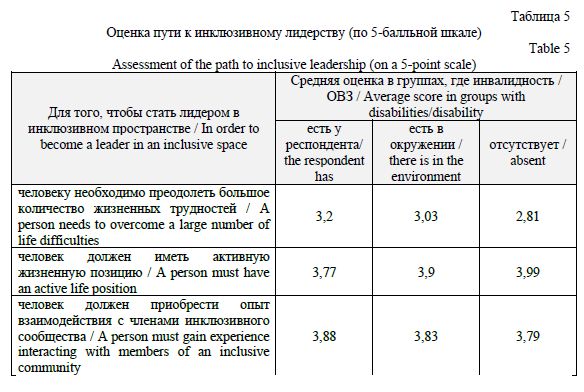The image of an inclusive leader in the perception of student youth
The development of youth leadership potential is closely linked to the educational environment, which serves as a unique space for interaction among students with diverse needs and abilities. It is within this environment that perceptions of leadership are shaped, influencing young people over an extended period. However, inclusive leadership and its perception within the youth community remain insufficiently studied in sociology. This article presents an original definition of the “image of an inclusive leader”, which is an adapted sociological concept of the “social portrait”, taking into account the specifics of inclusion and youth leadership. To empirically validate this concept, the author conducted a sociological study using an online survey (N = 295) among students of Russian universities that are part of the Resource Educational & Methodical Center network. The questionnaire included three sections: the social portrait of an inclusive leader, the specifics of its perception by youth, and respondent demographic data. The study results indicate that young people have a well-formed understanding of an inclusive leader as a person with a specific set of personal qualities and values. Unlike traditional leadership, inclusive leadership is primarily expressed through supportive behavior and mentorship. The key characteristics of an inclusive leader valued by youth include empathy, high moral standards, and benevolence. The study also identified key factors influencing the perception of inclusive leadership, including the presence of disabilities or health limitations, gender, and age. While the willingness of young people to become inclusive leaders is relatively high, respondents highlighted significant barriers that require systemic support measures at the national level.
Figures





Semochkina, N. N., Rudneva, M. Ya. (2025), “The image of an inclusive leader in the perception of student youth”, Research Result. Sociology and management, 11 (3), 93-107. DOI: 10.18413/2408-9338-2025-11-3-0-6.


















While nobody left any comments to this publication.
You can be first.
Afonkina, Ju. A. (2015), “Social inclusion of persons with disabilities and the problem of human dignity”, Russian Journal of Education and Psychology, (11 (55)), 149-162, EDN: VKGQKL. (In Russian)
Banch, G. O., and Ryapisov, N. A. (2017), “The role of leadership in the development of inclusive education”, Sibirsky pedagogichesky zhurnal, (6), 108-114, EDN: SZXZHV. (In Russian)
Volosnikova, L. M. (2023), “Leadership in inclusive education: modern discourse”, Vestnik Nizhnevartovskogo gosudarstvennogo universiteta, (2), 17-25, DOI: 10.36906/2311-4444/23-2/02, EDN: XMGCWZ. (In Russian)
Volosnikova, L. M., Fedina, L. V., and Bruk, Zh. Ju. “Positions of leaders – directors of inclusive schools: foreign discourse”, Sotsialnaya psikhologya i obshhestvo, 2024, 15 (1), 22-38, DOI: 10.17759/sps.2024150102, EDN: LYBEXZ. (In Russian)
Gorshkov, M. K., and Sheregi, F. Je. (2010), Molodezh Rossii: sotsiologichesky portret [Youth of Russia: a sociological portrait], CSPiM, Moscow, Russia. (In Russian)
Ibragimova, A. S. (2009), “On the issue of leadership theories: a sociological approach”, Vestnik ekonomiki, prava i sotsiologii, (3), 82-85, EDN: KWYGOD. (In Russian)
INAB №4 - 2007. Molodezh novoy Rossii: obraz zhizni i tsennostnye prioritety [INAB No. 4 - 2007. Youth of the new Russia: lifestyle and value priorities] (2007), ISRAN, Moscow, Russia. (In Russian)
Mahyanova, A. V., and Tahautdinova, I. I. (2018), “Economic activity indices in compiling a social portrait of the poor strata of the population”, Vestnik ekonomiki, prava i sotsiologii, (1), 262-266, EDN: YWREFB. (In Russian)
Medvedeva, E. S. (2022), “Involvement of students with disabilities and people with disabilities in the work of the volunteer movement”, Vserossyskaya konferentsya po voprosam dostupnosti professionalnogo obrazovanya [All-Russian Conference on Accessibility of Professional Education], N.E. Bauman MSTU, Moscow, Russia, 129-131, EDN: RMIWIS. (In Russian)
Rylshhikova, O. G. (2022), “Studying leadership in the modern youth environment”, Stolypinsky vestnik, (7), 52, EDN: OSAQLQ. (In Russian)
Silnova, E. I. (2014), “Conceptualization of the concept of “social image” in social philosophy”, Sovremennye problemy nauki i obrazovanya, (5), 688, EDN: SZVSWP. (In Russian)
Ermolaeva, P. O., Noskova, E. P., Zainullina, M. R., Kuptsova, A. I., and Nagimova, A. M. (2014), Sotsialny portret naselenya: metodologya, osnovnye kharakteristiki [Social portrait of the population: methodology, main characteristics], Artifakt, Kazan, Russia, EDN: THOTMN. (In Russian)
Fazleeva, L. R. (2020), “Development of leadership qualities of university students in the process of implementing social projects in an inclusive educational environment”, Inkljuzya v universitetah: globalnye trendy i lokalnye strategii [Inclusion in Universities: Global Trends and Local Strategies], Znanie, Tumen, Russia, 228-231, EDN: KWDDDL. (In Russian)
Fantaccini, D., Shakleina, M. V., and Juras, N. A. (2018), “Big Data in determining the social well-being of the population of Russia”, Prikladnaya ekonometrika, (50), 43-66. (In Russian)
Khozinov, R.R. (2016), “Youth leadership in managerial relationships: a conceptual analysis”, Vestnik VJeGU, 1(81), 146-151, EDN: VLJFLH. (In Russian)
UNESCO (2007), Rukovodstvo po inklyuzii: obespechenie dostupa k obrazovanyu dlya vseh [Inclusion Guide: Ensuring Access to Education for All], Translated by S. Kotova, Perspektiva, TranzitIKS, Moscow, Vladimir, Russia. (In Russian)
Furtado, L., Carvalho, J., and Sobral, F. (2024), “Inclusive leadership: pushing the field forward”, Revista de Administração de Empresas, 64, available at: URL: https://periodicos.fgv.br/rae/article/view/91933 (Accessed 08 March 2025).
Mor Barak, M., Brimhall, K., Luria, G., and Ozbilgin, M. (2024), “How do Inclusive Leaders Emerge? A Theory-Based Model,” Management Learning, 1-40.
Randel, A. E., Galvin, B. M., Shore, L. M., Ehrhart, K. H., Chung, B. G., Dean, M. A., and Kedharnath, U. (2018), “Inclusive leadership: Realizing positive outcomes throughbelongingness and being valued for uniqueness,” Human Resource Management Review, 28 (2), 190-203, DOI: 10.1016/j.hrmr.2017.07.002.